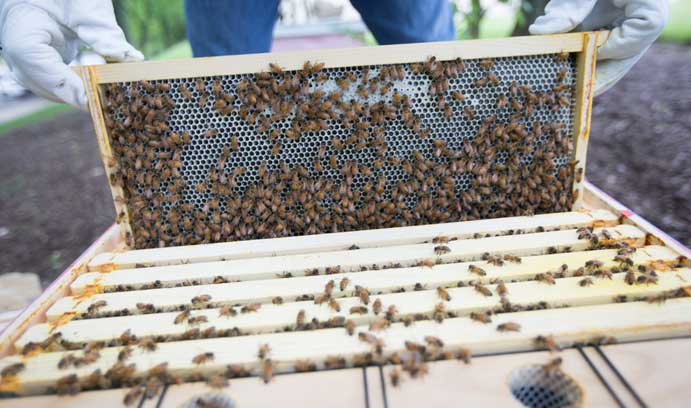What’s that buzz?

Honeybees are hard at work at Lehigh's new apiary on the Mountaintop campus.
On a short hill on Lehigh’s Mountaintop campus, under a canopy of lush trees, a newly installed collection of man-made beehives sits atop cinder blocks. Nearby, a community garden grows. Birds chirp. And bright yellow signs caution visitors: “Honeybees hard at work. Do not disturb.”
This is Lehigh’s apiary, a project of the newly formed Lehigh University Beekeeping Club that aims to raise awareness of the plight of the honeybee and promote environmental sustainability. As the tens of thousands of bees hopefully reproduce and build up their hives, students will eventually be able to harvest honey and beeswax while learning how superorganisms live.
Who’s behind the buzz?
Economics major Katherine Ballen ’16, under the guidance of the College of Education’s marketing director Tamara Bartolet, applied for—and received earlier this year—a $2,000 Lehigh GreenFund grant to buy the bees and equipment and launch the project.
Ballen also won approval from Lehigh’s Student Senate to establish a beekeeping club on campus, under the mentorship of the Lehigh Valley Beekeeping Association.
“The Lehigh community came together in a quick way,” said Bartolet. “It speaks volumes about our commitment to sustainability.”
In April, the manmade hives were installed outside the College of Education, away from any regular foot traffic, and three colonies of honeybees (some 30,000 bees) took up residence. Since then, the bees’ population has likely doubled.
Now the honeybees, with their hives located just a few feet from one of Lehigh’s educational community gardens, will help pollinate the area and increase vegetation and environmental sustainability. The club plans to host workshops on the importance of honeybees and the ways people can help sustain the Earth.
It’s a critical time. Honeybees, which pollinate such crops as apples, berries, cucumbers and alfalfa, have been dying or disappearing by the tens of millions around the world from a condition known as colony collapse disorder. Biologists suspect that a combination of plant pesticides and insecticides have been contaminating the pollen that honeybees collect to feed their hives. The global economic cost of the disorder, including lower crop yields, has been estimated at $5.7 billion annually.
“I wanted to raise awareness for the dying bee population. Not that many people know about it,” said Ballen, 20.“If we keep ignoring what’s happening, it’s going to get worse.”
Ballen’s interest in bees started in an independent study course in high school and grew out of her reading of Latin poet Virgil’s the Georgics. (The poem’s Book Four deals with the life and habits of bees, a comparative model of Roman society.)
Ballen subsequently established and maintained a bee hive at her high school. Then, at the start of her sophomore year at Lehigh, she began researching college bee clubs and the steps needed to possibly bring beehives to campus. She sought, and received, the necessary approvals.
“Now is the chance to help the honeybee and to help ourselves,” Ballen wrote in the grant application to the Lehigh GreenFund. “The bee population is now at its lowest in the last 50 years and is only decreasing. The United States has recently experienced the highest loss of honeybee populations so far, with most of the nation’s beekeepers losing anywhere from 50 to 90 percent of their bee population.”
Honeybees are among the least recognized workers in agriculture, Ballen wrote. They pollinate more than $15 billion in crops in the United States each year and produce about $150 million in honey. Without pollination, some fruits would not grow or their quality would be poor.
“That’s why honeybees are so critical,” said Steve Fink, president of the Lehigh Valley Beekeepers Association.
The Lehigh students are the first college students in the region that his association is helping to mentor, he said, and he’s happy for it.
“It takes a university with the right culture to accept and allow that sort of thing,” he said.
Ballen and her friends helped with installation in April. The plan is for Lehigh students to maintain the hives on campus, including over the summer, with students observing, recording and learning from the bees’ progress. Though the new club has more than 50 members, regular meetings have not yet begun.
In the transition between semesters, Bartolet and her husband, Dan, have been helping to maintain the hives, providing sugar water for the bees and checking on the health of the hives. The Lehigh bees already have needed more room, and Sarah Jacobs, of the Lehigh Valley Beekeepers Association, added more height to the hives.
After the first year, when the bees are hopefully thriving, students will look to harvest the honey. Ballen said she is not sure what the club will decide to do. Options would include: giving the honey to the university for use, selling it and investing the proceeds back into the club or donating the honey to burn victims. (Honey can soothe burns.)
“I feel good about it,” said Ballen about the new beekeeping club and apiary. “I’m excited for it.”
Photos by Christa Neu
Posted on:





